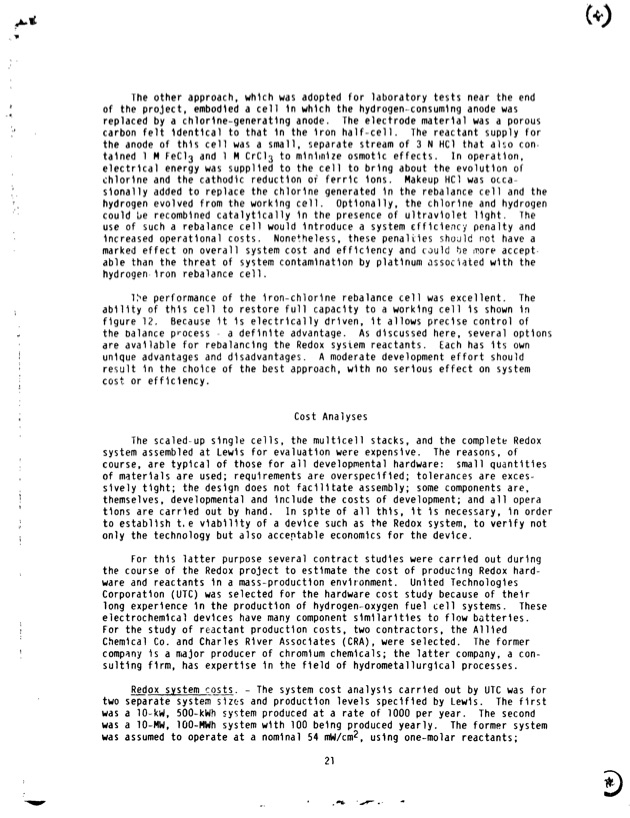
PDF Publication Title:
Text from PDF Page: 024
The other approach, which was adopted for laboratory tests near the end of the project, embodied a cell In which the hydrogen-consuming anode was replaced by a chlorine-generating anode. The electrode material was a porous carbon felt identical to that in the iron half-cell. The reactant supply for the anode of this cell was a small, separate stream of 3 N HC1 that also con- tained 1 M FeC13 and 1 M CrC13 t o minilnize osmotic effects. I n operation, electrical energy was supplied to the cell to bring about the evolution of chlorine and the cathodic reduction of ferric ions. Makeup HCl was occa- sionally added to replace the chlorine generated in the rebalance cell and the hydrogen evolved from the working cell. Optional1y, the chlorine and hydrogen could be recombined catalytically in the presence of ultraviolet light. The use of such a rebalance cell would introduce a system ~fficlencypenalty and increased operational costs. Nonetheless, these penaliies shodld PO! have a marked effect on overall system cost and efficiency and caulcl 2e trore accept- able than the threat of system contamination by platinum associated with the hydrogen-1ron rebalance cell. I>e performance of the iron-chlorine rebalance cell was excellent. The ability of this cell to restore full capacity to a working cell is shown in figure 12. Because jt is electrically driven, It allows precise control of the balance process - a definite advantage. As discussed here, several options are available f o r rebalancing the Redox sysiem reactants. Each has i t s own unique advantages and disadvantages. A moderate development e f f o r t should result in the choice of the best approach, with no serious effect on system cost or efficiency. Cost Analyses The scaled-up single cells, the multlcell stacks, and the complete Redox system assembled at Lewis for evaluatlon were expensive. The reasons, of course, are typical of those for a l l developmental hardware: small quantities of materials are used; requirements are overspecified; tolerances are exces- sively tight; the design does not facilitate assembly; some components are, themselves, developmental and include the costs of development; and a l l opera tions are carrqed out by hand. I n spite of a l l this, it i s necessary, I n order to establlsh t,e viability of a device such as the Redox system, to verify not only the technology but also acceptable economics for the device. For this latter purpose several contract studies were carried out during the course of the Redox project to estimate the cost of producing Redox hard- ware and reactants i n a mass-production envlr.onment. United Technologies Corporation (UTC) was selected for the hardware cost study because of their long experience I n the production of hydrogen-oxygen fuel cell systems. These electrochemical devices have many component similarities to flow bstterles. For the study of reactant production costs, two contractors, the Allied Chemical Co. and Charles River Associates (CRA), were selected. The former company i s a major producer of chromium chemicals; the latter company, a con- sulting firm, has expertise In the field of hydrometallurgical processes. Redox system ctsfi. - The system cost analysis carried out by UTC was for two separate system slzes and production levels specified by Lewis. The f i r s t was a 10-kJ, 500-kwh system produced a t a rate of 1000 per year. The second was a 10-MW, 100-MWh system with 100 being produced yearly. The former system was assumed to operate at a nomlnal 54 mW/cm2, using one-molar reactants;PDF Image | NASA Redox Storage System Development Project

PDF Search Title:
NASA Redox Storage System Development ProjectOriginal File Name Searched:
19850004157.pdfDIY PDF Search: Google It | Yahoo | Bing
CO2 Organic Rankine Cycle Experimenter Platform The supercritical CO2 phase change system is both a heat pump and organic rankine cycle which can be used for those purposes and as a supercritical extractor for advanced subcritical and supercritical extraction technology. Uses include producing nanoparticles, precious metal CO2 extraction, lithium battery recycling, and other applications... More Info
Heat Pumps CO2 ORC Heat Pump System Platform More Info
| CONTACT TEL: 608-238-6001 Email: greg@infinityturbine.com | RSS | AMP |